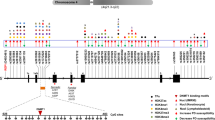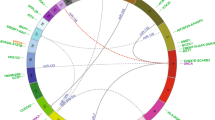Abstract
Synucleinopathies are neurodegenerative disorders characterized by the accumulation of pathological aggregates of alpha-synuclein protein in central nervous system cells. Parkinson’s disease (PD) and multiple system atrophy (MSA) are the most common variants of synucleinopathies. The exact causes of these disorders are still unknown, but it is well established that both genetic and environmental factors are involved. Both polymorphisms in the MAPT gene and dysregulation of epigenetic mechanisms, particularly, methylation of transcription regulation regions of the genes, are risk factors of synucleinopathy development. We examined the influence of methylation level of the MAPT gene on the development of PD and MSA and performed a clinical and epigenetic comparison. We identified hypermethylation of three CpG sites in the promotor region of the MAPT gene in the group of MSA patients in comparison with controls. We also identified significant differences in methylation level of four CpG sites in the promotor region between MAPT haplotypes in the MSA group, and the protective H2 haplotype was hypomethylated. The modifying role of age and antiparkinsonian therapy with dopamine receptor agonists on the methylation level of the MAPT gene was established. The data obtained in comparative analysis of the methylation level in the group of synucleinopathies indicate the potential protective role of MAPT hypomethylation, as we found predominantly hypomethylated status of CpG sites in the control group, hypomethylation of protective H2 allele of the MAPT gene, and age-dependent increase in hypermethylation.


Similar content being viewed by others
REFERENCES
Kovacs, G.G., Molecular pathological classification of neurodegenerative diseases: turning towards precision medicine, Int. J. Mol. Sci., 2016, vol. 17, no. 2, p. 189. https://doi.org/10.3390/ijms17020189
McCann, H., Stevens, C.H., Cartwright, H., and Halliday, G.M., α-Synucleinopathy phenotypes, Parkinsonism Relat. Disord., 2014, vol. 20, suppl. 1, pp. 62—67. https://doi.org/10.1016/S1353-8020(13)70017-8
Bertram, L. and Tanzi, R.E., The genetic epidemiology of neurodegenerative disease, J. Clin. Invest., 2005, vol. 115, no. 6, pp. 1449—1457. https://doi.org/10.1172/JCI24761
Hirsch, L., Jette, N., Frolkis, A., et al., The incidence of Parkinson’s disease: a systematic review and meta-analysis, Neuroepidemiology, 2016, vol. 46, no. 4, pp. 292—300. https://doi.org/10.1159/000445751
Karimi-Moghadam, A., Charsouei, S., Bell, B., and Jabalameli, M.R., Parkinson disease from mendelian forms to genetic susceptibility: new molecular insights into the neurodegeneration process, Cell. Mol. Neurobiol., 2018, vol. 38, no. 6, pp. 1153—1178. https://doi.org/10.1007/s10571-018-0587-4
Schrag, A., Ben-Shlomo, Y., and Quinn, N.P., Cross sectional prevalence survey of idiopathic Parkinson’s disease and Parkinsonism in London, BMJ., 2000, vol. 321, no. 7252, pp. 21—22. https://doi.org/10.1136/bmj.321.7252.21
Jankovic, J., Parkinson’s disease: clinical features and diagnosis, J. Neurol. Neurosurg. Psychiatry, 2008, vol. 79, no. 4, pp. 368—376. https://doi.org/10.1136/jnnp.2007.131045
Dickson, D.W., Parkinson’s disease and parkinsonism: neuropathology, Cold Spring Harb. Perspect. Med., 2012, vol. 2, no. 8. a009258. https://doi.org/10.1101/cshperspect.a009258
Jankovic, J. and Tan, E.K., Parkinson’s disease: etiopathogenesis and treatment, J. Neurol. Neurosurg. Psychiatry, 2020, vol. 91, no. 8, pp. 795—808. https://doi.org/10.1136/jnnp-2019-322338
Simón-Sánchez, J., Schulte, C., Bras, J.M., et al., Genome-wide association study reveals genetic risk underlying Parkinson’s disease, Nat. Genet., 2009, vol. 41, no. 12, pp. 1308—1312. https://doi.org/10.1038/ng.487
Nalls, M.A., Pankratz, N., Lill, C.M., et al., Large-scale meta-analysis of genome-wide association data identifies six new risk loci for Parkinson’s disease, Nat. Genet., 2014, vol. 46, no. 9, pp. 989—993. https://doi.org/10.1038/ng.3043
Chang, D., Nalls, M.A., Hallgrímsdóttir, I.B., et al., A meta-analysis of genome-wide association studies identifies 17 new Parkinson’s disease risk loci, Nat. Genet., 2017, vol. 49, no. 10, pp. 1511—1516. https://doi.org/10.1038/ng.3955
Ozawa, T., Paviour, D., Quinn, N.P., et al., The spectrum of pathological involvement of the striatonigral and olivopontocerebellar systems in multiple system atrophy: clinicopathological correlations, Brain J. Neurol., 2004, vol. 127, part 12, pp. 2657—2671. https://doi.org/10.1093/brain/awh303
Yoshida, M., Multiple system atrophy: alpha-synuclein and neuronal degeneration, Neuropathology, 2007, vol. 27, no. 5, pp. 484—493. https://doi.org/10.1111/j.1440-1789.2007.00841.x
Sailer, A., Scholz, S.W., Nalls, M.A., et al., A genome-wide association study in multiple system atrophy, Neurology, 2016, vol. 87, no. 15, pp. 1591—1598. https://doi.org/10.1212/WNL.0000000000003221
Portela, A. and Esteller, M., Epigenetic modifications and human disease, Nat. Biotechnol., 2010, vol. 28, no. 10, pp. 1057—1068. https://doi.org/10.1038/nbt.1685
Waddington, C.H., The epigenotype, 1942, Int. J. Epidemiol., 2012, vol. 41, no. 1, pp. 10—13. https://doi.org/10.1093/ije/dyr184
Marques, S., Oliveira, C., Pereira, C., and Outeiro, T., Epigenetics in neurodegeneration: a new layer of complexity, Prog. Neuropsychopharmacol. Biol. Psychiatry, 2011, vol. 35, no. 2, pp. 348—355. https://doi.org/10.1016/j.pnpbp.2010.08.008
Wüllner, U., Kaut, O., de Boni, L., et al., DNA methylation in Parkinson’s disease, J. Neurochem., 2016, vol. 139, suppl. 1, pp. 108—120. https://doi.org/10.1111/jnc.13646
Chartier-Harlin, M.C., Kachergus, J., Roumier, C., et al., Alpha-synuclein locus duplication as a cause of familial Parkinson’s disease, Lancet, 2004, vol. 364, no. 9440, pp. 1167—1169. https://doi.org/10.1016/S0140-6736(04)17103-1
Miller, D.W., Hague, S.M., Clarimon, J., et al., Alpha-synuclein in blood and brain from familial Parkinson disease with SNCA locus triplication, Neurology, 2004, vol. 62, no. 10, pp. 1835—1838. https://doi.org/10.1212/01.wnl.0000127517.33208.f4
Nemani, V.M., Lu, W., Berge, V., et al., Increased expression of alpha-synuclein reduces neurotransmitter release by inhibiting synaptic vesicle reclustering after endocytosis, Neuron, 2010, vol. 65, no. 1, pp. 66—79. https://doi.org/10.1016/j.neuron.2009.12.023
Scott, D.A., Tabarean, I., Tang, Y., et al., A pathologic cascade leading to synaptic dysfunction in alpha-synuclein-induced neurodegeneration, J. Neurosci., 2010, vol. 30, no. 24, pp. 8083—8095. https://doi.org/10.1523/JNEUROSCI.1091-10.2010
Jowaed, A., Schmitt, I., Kaut, O., and Wullner, U., Methylation regulates alpha-synuclein expression and is decreased in Parkinson’s disease patients’ brains, J. Neurosci., 2010, vol. 30, no. 18, pp. 6355—6359. https://doi.org/10.1523/JNEUROSCI.6119-09.2010
Matsumoto, L., Takuma, H., Tamaoka, A., et al., CpG demethylation enhances alpha-synuclein expression and affects the pathogenesis of Parkinson’s disease, PLoS One, 2010, vol. 5, no. 11. e15522. https://doi.org/10.1371/journal.pone.0015522
Ai, S.X., Xu, Q., Hu, Y.C., et al., Hypomethylation of SNCA in blood of patients with sporadic Parkinson’s disease, J. Neurol. Sci., 2014, vol. 337, nos. 1—2, pp. 123—128. https://doi.org/10.1016/j.jns.2013.11.033
Tan Y.Y., Wu L., Zhao Z.B., et al., Methylation of α-synuclein and leucine-rich repeat kinase 2 in leukocyte DNA of Parkinson’s disease patients, Parkinsonism Relat. Disord., 2014, vol. 20, no. 3, pp. 308—313. https://doi.org/10.1016/j.parkreldis.2013.12.002
Pihlstrøm, L., Berge, V., Rengmark, A., and Toft, M., Parkinson’s disease correlates with promoter methylation in the α-synuclein gene, Mov. Disord., 2015, vol. 30, no. 4, pp. 577—580. https://doi.org/10.1002/mds.26073
Schmitt, I., Kaut, O., Khazneh, H., et al., L-dopa increases α-synuclein DNA methylation in Parkinson’s disease patients in vivo and in vitro, Mov. Disord., 2015, vol. 30, no. 13, pp. 1794—1801. https://doi.org/10.1002/mds.26319
Kwok, J.B., Teber, E.T., Loy, C., et al., Tau haplotypes regulate transcription and are associated with Parkinson’s disease, Ann. Neurol., 2004, vol. 55, no. 3, pp. 329—334. https://doi.org/10.1002/ana.1082614991810
Vilarino-Güell, C., Soto-Ortolaza, A.I., Rajput, A., et al., MAPT H1 haplotype is a risk factor for essential tremor and multiple system atrophy, Neurology, 2011, vol. 76, no. 7, pp. 670—672. https://doi.org/10.1212/WNL.0b013e31820c30c1
Ezquerra, M., Pastor, P., Gaig, C., et al., Different MAPT haplotypes are associated with Parkinson’s disease and progressive supranuclear palsy, Neurobiol. Aging, 2011, vol. 32, no. 3, p. 547. e11-6. https://doi.org/10.1016/j.neurobiolaging.2009.09.011
Caillet-Boudin, M.L., Buée, L., Sergeant, N., and Lefebvre, B., Regulation of human MAPT gene expression, Mol. Neurodegener., 2015, vol. 10, no. 28, pp. 1—14. https://doi.org/10.1186/s13024-015-0025-8
Gilman, S., Wenning, G.K., Low, P.A., et al., Second consensus statement on the diagnosis of multiple system atrophy, Neurology, 2008, vol. 71, no. 9, pp. 670—676. https://doi.org/10.1212/01.wnl.0000324625.00404.15
Coupland, K.G., Mellick, G.D., Silburn, P.A., et al., DNA methylation of the MAPT gene in Parkinson’s disease cohorts and modulation by vitamin E in vitro, Mov. Disord., 2014, vol. 29, pp. 1606—1614. https://doi.org/10.1002/mds.25784
Iwata, A., Nagata, K., Hatsuta, H., et al., Altered CpG methylation in sporadic Alzheimer’s disease is associated with APP and MAPT dysregulation, Hum. Mol. Genet., 2014, vol. 23, no. 3, pp. 648—656. https://doi.org/10.1093/hmg/ddt451
Hoffmann, A., Sportelli, V., Ziller, M., and Spengler, D., Driver or passenger: epigenomes in Alzheimer’s disease, Epigenomes, 2017, vol. 1, no. 1, article 5. https://doi.org/10.3390/epigenomes1010005
Li, Y., Chen, J.A., Sears, R.L., et al., An epigenetic signature in peripheral blood associated with the haplotype on 17q21.31, a risk factor for neurodegenerative tauopathy, PLoS Genet., 2014, vol. 10, no. 3. e1004211
Funding
The present study had no financial support.
Author information
Authors and Affiliations
Corresponding author
Ethics declarations
Conflict of interest. The authors declare no conflict of interest.
Statement of compliance with standards of research involving humans as subjects. All procedures performed in studies involving human participants were in accordance with the ethical standards of the institutional and/or national research committee and with the 1964 Helsinki Declaration and its later amendments or comparable ethical standards. Informed consent was obtained from all individual participants involved in the study.
Additional information
Translated by A. Kazantseva
Rights and permissions
About this article
Cite this article
Iakovenko, E.V., Abramycheva, N.Y., Fedotova, E.Y. et al. Methylation of MAPT Gene in Neurodegenerative Synucleinopathies. Russ J Genet 58, 576–584 (2022). https://doi.org/10.1134/S1022795422050118
Received:
Revised:
Accepted:
Published:
Issue Date:
DOI: https://doi.org/10.1134/S1022795422050118




